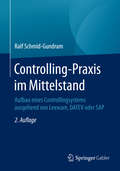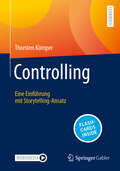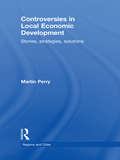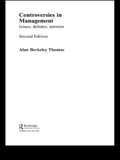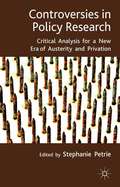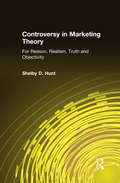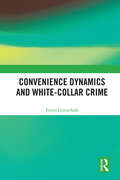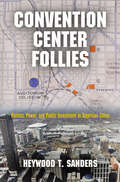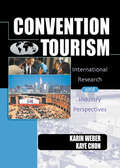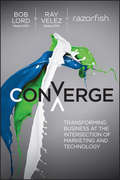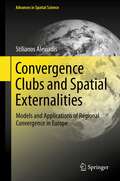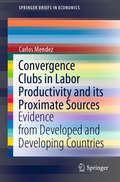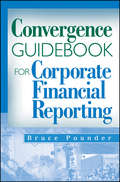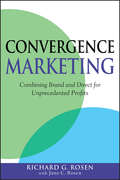- Table View
- List View
Controlling-Praxis im Mittelstand: Aufbau eines Controllingsystems ausgehend von Lexware, DATEV oder SAP
by Ralf Schmid-GundramIn Zeiten des verstärkten Wettbewerbes, Banken-Rating und Internationalisierung ist die Bedeutung des Controllings branchenunabhängig für alle Unternehmen gestiegen. Vor diesem Hintergrund gibt das Werk eine Einführung in die grundlegenden Controlling-Instrumente und erläutert detailliert und praxisnah den Aufbau von Controlling-Systemen für kleine, mittlere und mittelgroße Unternehmen. Neben den allgemeinen Anforderungen an Konzeption und Implementierung eines ganzheitlichen Controlling-Systems, werden auch die speziellen Anforderungen einzelner Branchen wie Handwerk, Dienstleistungsbereich, Handel und produzierendes Gewerbe/Industrie erläutert. Praxisnah werden zahlreiche Umsetzungsbeispiele für Lexware, DATEV und SAP aufgeführt. Diese Anleitung dient dazu, den eigenen Verantwortungsbereich oder das Unternehmen profitabel und zukunftssicher auszurichten und zu steuern.
Controlling-Praxis im Mittelstand: Aufbau eines Controllingsystems ausgehend von Lexware, DATEV oder SAP
by Ralf Schmid-GundramDieser Leitfaden zum strategischen Aufbau eines Controllingsystems mit MS Excel richtet sich gezielt an mittelständische Unternehmen jeder Größenklasse und Branche und erläutert übersichtlich und praxisnah die Konzeption und Implementierung von Controllingsystemen. Unternehmern und Controllern gelingt es mit dieser Anleitung, ein auf die jeweiligen Unternehmensbedürfnisse zugeschnittenes Controllingsystem auf MS-Excel-Basis erfolgreich zu etablieren.Die Anforderungen an mittelständische Unternehmen stehen denen an große, börsennotierte Unternehmen in nichts nach. Vom Kleinstunternehmen bis hin zur mittelständischen Unternehmensgruppe ist daher ein unternehmensindividuelles, komplexitätsreduziertes Controlling zwingend erforderlich, um das Unternehmen krisensicher auszurichten und erfolgreich zu führen. Mithilfe von zahlreichen Tipps, Praxisbeispielen und Screenshots sowie Checkup-Boxen wird spezifischen Aspekten von KMU Rechnung getragen. Ausgehend von den meistgenutzten Softwarelösungen für die Buchhaltung im Mittelstand (Lexware, DATEV und SAP) wird die schrittweise Einführung eines unternehmensspezifischen Controllingsystems erläutert und durch ein konkretes Umsetzungsbeispiel illustriert. Darüber hinaus wird ein Ausblick auf vollintegrierte Management-Informationssysteme (MIS) geboten, die in den letzten Jahren auch für mittelständische Unternehmen erschwinglich und praktikabel geworden sind. In der 3. Auflage wird verdeutlicht, wie KMU hierauf reagieren können und somit die Transformation von Controlling zu Business Intelligence bewerkstelligen können.
Controlling: Eine Einführung mit Storytelling-Ansatz
by Thorsten KümperFür die Unterstützung des Managements ist das Controlling unverzichtbar. Kenntnisse im Controlling sind nicht nur für Controller, sondern auch für andere Fach- und Führungskräfte elementar.Das Besondere an diesem Lehrbuch ist die konsequente Umsetzung des Storytellings, das über eine reine Vertiefung mit Hilfe von Fallstudien hinausgeht. Die einzelnen Controlling-Themen werden im Rahmen einer Geschichte erarbeitet und durch einzelne theoretische Vertiefungen außerhalb der Story ergänzt.Die Protagonistin Emma Hüsing beginnt nach ihrem BWL-Studium als Juniorcontrollerin. Sie muss in verschiedenen Controllingbereichen Herausforderungen durch die Anwendung geeigneter Instrumente bewältigen und entwickelt im Dialog mit anderen Personen Lösungen. Vorgesetzte und Mentoren teilen ihr Erfahrungswissen und im Freundes- und Familienkreis erläutert Emma in Gesprächen Grundsätzliches zum Controlling.Zur praktischen Anwendung sowie Vertiefung werden Rechnungen und Tabellen erläutert und Übungsaufgaben mit Lösungen bereitgestellt. Per Springer Nature-Flashcards-App stehen außerdem zusätzliche Fragen zur Verfügung, über die das erworbene Wissen kostenlos getestet werden kann.
Controls at the Sands Hotel and Casino
by Kenneth A. Merchant Jeffrey M. TraynorDescribes the controls used in the casino over the blackjack game and cash stocks, and movements of cash. Also describes the results measures available in the casino and their limitations for control purposes.
Controversies in Healthcare Innovation: Service, Technology And Organization
by Margunn Aanestad Antonella La Rocca Thomas HoholmThis book examines healthcare innovation processes, shedding light on the controversies endemic to innovation, which make such processes notoriously challenging. While, in the heat of action, controversies may be seen as barriers to innovation, observations reported in this volume point to controversies also having an energizing role. Students and academics studying innovation, organization, and health management and economics will find this book a valuable read as it provides empirical case studies on innovation processes in practice. Controversies in Healthcare Innovation will also appeal to practitioners of health care management, innovation project managers and policy-makers in the health care sector.
Controversies in Juvenile Justice and Delinquency (Controversies In Crime And Justice Ser.)
by Alida V. Merlo Peter J. BenekosAfter providing a history of the development of the juvenile court, this book explores some of the most important current controversies in juvenile justice. Original essays review major theories of juvenile delinquency, explore psychological and biological factors that may explain delinquent behavior, and examine the nexus between substance abuse and delinquency. A final chapter provides a comparative analysis.
Controversies in Local Economic Development: Stories, Strategies, Solutions (Regions And Cities Ser. #38)
by Martin PerryEfforts to promote the economic development of individual localities engage the attention of academics, students and professionals. Many such analysts argue that competitive advantage can be fostered within local economies, complimenting the advent of a more globalised economy. Intensified efforts to build new economic foundations show no sign of abating despite the apparent increase in the international mobility of businesses and employment. Unpicking the arguments supporting different strategies for promoting local economic development, Controversies in Local Economic Development is an introductory guide to some of the major ideas and policy tools that have influenced academic debate and development practice. Taking the view that economic processes are mechanisms that promote desired outcomes only in particular contexts, the book asks questions of both academic debates and the prescriptions of policy experts.
Controversies in Management: Issues, Debates, Answers
by Alan B ThomasAs managerial roles diversify, the phenomenon of management becomes increasingly puzzling. Demand for formal management training, theories and qualifications has increased, yet our ability to think critically about management has diminished. At a time of organizational and environmental turbulence, the question of effective management is more complex than ever. Unpicking the puzzles faced by both the manager and the student of management, this introductory guide explores the major issues of management, organization and knowledge, asking questions of our 'guru' culture and raising debates on so-called expert thinking. Written from the viewpoint that the most effective managers are those that can think for themselves and put aside the advice of the management 'guru', it is a topical, challenging and thought-provoking study. Thoroughly revised and reorganized, this second edition features two completely new chapters that cover gender issues in management, debates on globalization, post-modernity and the future of management. Designed to bring readers into the debate, rather than simply providing a framework of answers, this new edition also includes an orientation questionnaire, discussion questions for each area covered and further reading suggestions.
Controversies in Policing (Controversies In Crime And Justice Ser.)
by Quint Thurman Andrew GiacomazziThis book of original essays presents controversial topics, then encourages the readers to consider what they think ought to be done. The selections identify several of the existing issues in policing about which something needs to be done; then, they present various viewpoints on possible solutions. This is done against the backdrop of an era of significant change in worldwide security, post-9/11, that has caused major changes in the manner in which the U.S. conducts its political, social and economic affairs.
Controversies in Policy Research
by Stephanie PetrieUnder the themes of Justice, Participation and Social Exclusion contributors explore and discuss the impact on those targeted or excluded by important public and social policies in European countries. Contexts, consequences and controversies current in the global North are uncovered highlighting the ethical implications for policy research.
Controversies in Victimology (Controversies In Crime And Justice Ser.)
by Laura J. MoriartyControversies in Victimology features original works of noted scholars and practitioners, aiming to shed light on the debates over, the media attention on, and the psychology behind victimization. This book discusses the controversies from all sides of the debate, and attempts to reconcile the issues in order to move the field forward.
Controversies in White-Collar Crime (Controversies In Crime And Justice Ser.)
by Gary PotterOriginal writings explore the issue of white-collar crime and the controversies that surround it, focusing on the vastness of state-corporate and white-collar crime, the victimization that results, and the ways these crimes affect society environmentally, politically, economically and personally.
Controversy in Marketing Theory: For Reason, Realism, Truth and Objectivity
by Shelby D. HuntIn this book distinguished theorist and author Shelby D. Hunt analyzes the major controversies in the "philosophy debates" raging throughout the field of marketing. Using an historical approach, Hunt argues against relativism and for scientific realism as a philosophy for guiding marketing research and theory. He also shows how the pursuit of truth and objectivity in marketing research are both possible and desirable. Specific controversies analyzed in the book include: Does positivism dominate marketing research? Does positivism imply quantitive methods? Is relativism an appropriate foundation for marketing research? Does relativism imply pluralism, tolerance, and openness? Should marketing pursue the goal of objective research? An ideal companion to Hunt's classic text, Foundations of Marketing Theory, this volume will be equally useful on its own in any graduate level course on marketing theory.
Convence sin abrir la boca: Claves del lenguaje no verbal para persuadir a cualquier audiencia
by Jordi RecheDescubre las claves del lenguaje no verbal para cautivar y persuadir a cualquier audiencia y en cualquier situación. En el entorno personal y profesional, nuestros gestos, miradas, posturas, sonrisas... dicen más de nosotros que las palabras que pronunciamos. Porque el lenguaje del cuerpo es revelador: cómo nos sentamos, cómo caminamos, cómo saludamos..., todo comunica. Los demás interpretan y recuerdan nuestros mensajes por lo que transmitimos a nivel visual mucho más que por lo que decimos. Pero ¿sabes qué expresas con tu cuerpo? Jordi Reche te descubre los secretos del lenguaje no verbal: qué significa cada gesto, por qué lo haces y cómo interpretarlo tanto en ti mismo como en los demás. Convence sin abrir la boca te proporciona las herramientas para dominar el lenguaje corporal y conectar con tus interlocutores. Aprende a utilizarlas para ser más convincente y persuasivo, transmitir mayor seguridad y confianza, y ganar influencia entre quienes te rodean. En este libro aprenderás: * A comunicar mejor, reforzando tu mensaje hablado con tu gestualidad. * A tener mayor consciencia de tu cuerpo y a utilizarlo para sentirte mejor y para que, quienes te rodean, te vean mejor. * A leer en los gestos de los demás información que han decidido no darte u ocultarte, o simplemente a descifrar que te están mintiendo.* A descubrir que tu poder de persuasión puede aumentar de manera significativa si cuidas tu lenguaje no verbal de líder. * A conocer mejor los mensajes que envían tus fotos de perfil, tus fotos grupales o los vídeos que cuelgas en las redes. * A detectar las emociones reales de una persona, más allá de lo que nos cuente con sus palabras. * A aumentar tu capacidad de seducción y a leer en el cuerpo de las personas con las que te relacionas si estás atrayendo su atención de manera positiva o no. Reseñas:«Con el libro de Jordi puedes aprender tanto a leer a los demás como a mejorar tu comunicación de una forma amena y entretenida. Puedes usarlo siempre que quieras para mejorar y llevar tu comunicación y conocimiento a otro nivel que no muchos conocen».Jose Fernández @soycriminologo. Experto en criminología y comportamiento no verbal«Jordi ha condensado en un libro una gran cantidad de trucos y técnicas para entender cómo funciona la comunicación no verbal. Esto permite que lo apliques es muchos ámbitos: en negociaciones, ventas, formaciones... Es un manual didáctico y directo que te ayudará a iniciarte de lleno en el apasionante mundo de la comunicación».Fernando Miralles. Formador y divulgador experto en oratoria«Jordi te explica paso a paso todo lo que cualquier comunicador debería saber, ya sea hablando con un cliente o frente a miles de espectadores. Sin duda, una caja de herramientas que todo profesional debería leer. Un título obligatorio para cualquiera que desee destacarse en su carrera».Nico Fernández Miranda. Empresario, conferencista y profesor universitario«En este mundo tan expeditivo Jordi nos enseña no solo cómo mejorar nuestro lenguaje corporal sino también cómo leer a quienes tenemos enfrente, esto nos ayudara luego a complementar nuestro objetivo final en una reunión o quizás en esa charla incomoda que tanto evadimos. Aquí aprenderás cómo congeniar eso que quieres decir no solo con palabras si no con todo tu cuerpo».Evelina Cabrera. Entrenadora de fútbol, coach deportivo y escritora
Convenience Dynamics and White-Collar Crime
by Petter GottschalkThis book introduces a dynamic perspective to study white-collar crime. It argues that as personal motives change over time, so too do organizational opportunities, and willingness for deviant behaviour. The work contends that the extent of white-collar crime is dependent on the extent of crime convenience perceived and preferred by potential offenders. It discusses how potential white-collar offenders expand organizational opportunities for financial crime over time. The dynamics are illustrated here by system dynamics models to capture cause and effect relationships. The book also presents a new structural model illustrating the elements of convenience theory along with a new dynamic model illustrating the evolution of white-collar crime. The practical aspects are illustrated with a number of case studies. The book will be of interest to researchers, academics and professionals working in the areas of Criminal Justice, Criminology, Criminal Law and Business Studies.
Convention Center Follies: Politics, Power, and Public Investment in American Cities (American Business, Politics, and Society)
by Heywood T. SandersAmerican cities have experienced a remarkable surge in convention center development over the last two decades, with exhibit hall space growing from 40 million square feet in 1990 to 70 million in 2011—an increase of almost 75 percent. Proponents of these projects promised new jobs, new private development, and new tax revenues. Yet even as cities from Boston and Orlando to Phoenix and Seattle have invested in more convention center space, the return on that investment has proven limited and elusive. Why, then, do cities keep building them?Written by one of the nation's foremost urban development experts, Convention Center Follies exposes the forces behind convention center development and the revolution in local government finance that has privileged convention centers over alternative public investments. Through wide-ranging examples from cities across the country as well as in-depth case studies of Chicago, Atlanta, and St. Louis, Heywood T. Sanders examines the genesis of center projects, the dealmaking, and the circular logic of convention center development. Using a robust set of archival resources—including internal minutes of business consultants and the personal papers of big city mayors—Sanders offers a systematic analysis of the consultant forecasts and promises that have sustained center development and the ways those forecasts have been manipulated and proven false. This record reveals that business leaders sought not community-wide economic benefit or growth but, rather, to reshape land values and development opportunities in the downtown core.A probing look at a so-called economic panacea, Convention Center Follies dissects the inner workings of America's convention center boom and provides valuable lessons in urban government, local business growth, and civic redevelopment.
Convention Sales and Services,
by James R. AbbeyEach chapter opens with an insightful analysis of the chapter subject by outstanding practitioners in the meetings industry. This Ninth Edition provides even more comprehensive and up-to-date information-as well as additional features such as Internet Exercises, More Online boxes and Worth Watching video boxes.
Convention Tourism: International Research and Industry Perspectives
by Kaye Sung Chon Karin WeberStay up to date on international trends in convention tourism! Convention Tourism: International Research and Industry Perspectives is a thorough analysis of the industry’s key markets, combining insightful articles with detailed case studies. Equally valuable as a professional handbook, research reference guide, and textbook, this comprehensive book includes an account of the history of convention tourism and its economic contributions, marketing and human resources analyses, global and regional developments, and research issues and challenges. Convention Tourism addresses issues critical to the three key regions of the convention and meeting industry--North America, Europe, and Asia-Pacific. The book features a wide range of material from the top educators around the world, reflecting an international perspective befitting the industry’s growing trend toward globalization. Convention Tourism also presents in-depth studies that focus on the United States, the Mediterranean, Australia, and Korea, and takes a look ahead at likely business, technological, and social trends that are likely to affect the convention industry in the coming years. Convention Tourism also examines: proposed economic impact assessment framework regional planning and development initiatives education and training programs from industry associations and universities research resources international meeting managementAs more and more international sites compete with traditional markets for lucrative convention contracts, it is crucial that professionals, researchers, and academics have a global understanding of the industry’s past, present, and future. Convention Tourism is an essential overview of the most important element of the business tourism industry.
Conventional Water Resources and Agriculture in Egypt (The Handbook of Environmental Chemistry #74)
by Abdelazim M. NegmThis unique volume focuses on Egypt’s conventional water resources and the main water consumer: Egypt’s agriculture. It provides an up-to-date overview and the latest research findings, and covers the following main topics: · History of irrigation and irrigation projects · Key features of agriculture, the administrative and legal framework in Egypt · Land resources for agriculture development · Food insecurity due to water shortages and climate change; resulting challenges and opportunities · Assessment of water resources for irrigation and drinking purposes · Impacts of upstream dams, such as the GERD and Tekeze Dam, on Egypt’s water resources and crop yield · Sustainable use of water resources and the future of mega irrigation projects · Quantity and quality of water in Egypt’s water resources bank This book and the companion volume Unconventional Water Resources and Agriculture in Egypt offer invaluable reference guides for postgraduates, researchers, professionals, environmental managers and policymakers interested in water resources and their management worldwide.
Converge: Transforming Business at the Intersection of Marketing and Technology
by Bob W. Lord Ray VelezThe leaders of Razorfish share their strategies for merging marketing and IT To create rich, technologically enabled experiences, enterprises need close collaboration between marketing and IT. Converge explains how the merging of technology, media, and creativity is revolutionizing marketing and business strategy. The CEO and CTO of Razorfish, one of the world's largest digital marketing agencies, give their unique perspective on how to thrive in this age of disruption. Converge shares their first-hand experience working closely with global brands--including AXE, Intel, Samsung, and Kellogg--to solve business problems at the collision point between media, technology, and marketing. With in-depth looks at cloud computing, data- and API-enabled creativity, ubiquitous computing, and more, Converge presents a roadmap to success. Explains how to organize for innovation within your own organization by applying the principles of agile development across your business Details how to create a religion around convergence, explaining how to tell the story throughout the organization Outlines how to adapt processes to keep up with and take advantage of rapid technological change A book by practitioners for practitioners, Converge is about rethinking business organizations for a new age and empowering your people to thrive in a brand, new world.
Convergence Clubs and Spatial Externalities: Models and Applications of Regional Convergence in Europe (Advances in Spatial Science)
by Stilianos AlexiadisDo dynamic externalities, in the form of technology creation, adoption and spatial agglomeration shape the pattern of regional growth in Europe? This study provides an alternative view on regional convergence. A model is developed which attributes club-convergence to existing differences with respect to the degree of technology adoption. In the first instance, empirical results suggest that the NUTS-2 regions of the EU-27 converge at a very slow rate. Further tests, however, indicate that convergence is restricted to a specific subset of regions. Such conclusions are tested further, using an alternative model of club-convergence, which incorporates the impact of spatial interaction, agglomeration externalities and technology. This shows that the convergence-club in Europe follows a certain geographical pattern and all members share similar characteristics regarding technology creation and adoption, and agglomeration externalities.
Convergence Clubs in Labor Productivity and its Proximate Sources: Evidence from Developed and Developing Countries (SpringerBriefs in Economics)
by Carlos MendezTesting for economic convergence across countries has been a central issue in the literature of economic growth and development. This book introduces a modern framework to study the cross-country convergence dynamics in labor productivity and its proximate sources: capital accumulation and aggregate efficiency. In particular, recent convergence dynamics of developed as well as developing countries are evaluated through the lens of a non-linear dynamic factor model and a clustering algorithm for panel data. This framework allows us to examine key economic phenomena such as technological heterogeneity and multiple equilibria. In this context, the book provides a succinct review of the recent club convergence literature, a comparative view of developed and developing countries, and a tutorial on how to implement the club convergence framework in the statistical software Stata.
Convergence Guidebook for Corporate Financial Reporting
by Bruce PounderAs a result of the global convergence of financial reporting standards, U.S. GAAP is changing profoundly. U.S. GAAP is also being abandoned by many public and private companies, and will eventually be replaced by a higher-quality set of global standards. The Convergence Guidebook for Corporate Financial Reporting provides the timely, practical guidance that CFOs, controllers, and other financial managers need in order to prepare for the impact of Convergence on their companies, departments, and careers. Guidebook readers will also learn why they must begin preparing for "the next big challenge in corporate financial reporting" now.
Convergence Innovation in Asian Industries
by Kong-Rae LeeThis book deals with both the understanding of, and the explanation of, knowledge about the causes, processes, and patterns of convergence innovation. It argues that the process of convergence innovation is a continuous disequilibrium between reference technology and its matching technology, adjusting the optimal balance between the functions of the two technologies. Contributors describe how convergence innovation is a learning process that requires both vertical and horizontal convergence, and case studies explore the different types of convergence innovation such as outside-in and inside-out. Convergence innovation has been taking place mainly by applying IT technologies to vast areas of conventional technologies, so that individuals or firms reap the benefits of the convergence between IT and conventional technologies. Such innovations are made possible by convergence, and they ultimately improve the welfare of human beings as companies solve diverse problems and increase employment. Examples in this book include biochemical companies in Indonesia, who were able to increase their market shares in bio-fertilizer and bio-pesticide products through bio-based technological convergence; and textile machinery firms in South Korea who have been survived by achieving convergence innovation on their core competences. This book was originally published as a special issue of the Asian Journal of Technology Innovation.
Convergence Marketing
by Richard RosenOffering a common language, better processes, and a set of practical tools, Convergence Marketing is a real-world guide that successfully combines the best of brand and direct into something more powerful and effective than either can be on its own. Convergence marketing offers the kind of real-time accountability that positions marketing as a vital and effective component of leadership's overall business strategy. Convergence brings brand and direct together with respect to both disciplines, within the same silos. And it offers the necessary tools and processes that deliver better results. Our global market demands nothing less than this fully integrated approach. Convergence Marketing is the key to shifting marketing communications efforts from a cost-based to a profit-driven model and will have your CFO begging you to spend more money.
